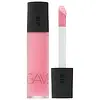What's inside
What's inside
 Key Ingredients
Key Ingredients

No key ingredients
 Benefits
Benefits

 Concerns
Concerns

 Ingredients Side-by-side
Ingredients Side-by-side

Octyldodecanol
EmollientSqualane
EmollientGlycerin
HumectantWater
Skin ConditioningIsopropyl Palmitate
EmollientAdansonia Digitata Seed Oil
EmollientAvena Sativa Kernel Oil
Skin ConditioningCaprylic/Capric Triglyceride
MaskingCitrus Grandis Fruit Water
MaskingPhenoxyethanol
PreservativeOryza Sativa Bran Extract
Skin ConditioningDimethyl Isosorbide
SolventAroma
Sucrose Stearate
EmollientSucrose Laurate
EmollientSodium Chloride
MaskingHelianthus Annuus Extract
EmollientAgave Tequilana Leaf Extract
AstringentSesamum Indicum Seed Extract
Skin ConditioningRicinus Communis Seed Oil
MaskingRosmarinus Officinalis Leaf Extract
AntimicrobialTocopherol
AntioxidantMomordica Grosvenorii Fruit Extract
AntioxidantCI 17200
Cosmetic ColorantLimonene
PerfumingOctyldodecanol, Squalane, Glycerin, Water, Isopropyl Palmitate, Adansonia Digitata Seed Oil, Avena Sativa Kernel Oil, Caprylic/Capric Triglyceride, Citrus Grandis Fruit Water, Phenoxyethanol, Oryza Sativa Bran Extract, Dimethyl Isosorbide, Aroma, Sucrose Stearate, Sucrose Laurate, Sodium Chloride, Helianthus Annuus Extract, Agave Tequilana Leaf Extract, Sesamum Indicum Seed Extract, Ricinus Communis Seed Oil, Rosmarinus Officinalis Leaf Extract, Tocopherol, Momordica Grosvenorii Fruit Extract, CI 17200, Limonene
Ingredients Explained
These ingredients are found in both products.
Ingredients higher up in an ingredient list are typically present in a larger amount.
This ingredient is an emollient, solvent, and texture enhancer. It is considered a skin-softener by helping the skin prevent moisture loss.
It helps thicken a product's formula and makes it easier to spread by dissolving clumping compounds.
Caprylic Triglyceride is made by combining glycerin with coconut oil, forming a clear liquid.
While there is an assumption Caprylic Triglyceride can clog pores due to it being derived from coconut oil, there is no research supporting this.
Learn more about Caprylic/Capric TriglycerideGlycerin is already naturally found in your skin. It helps moisturize and protect your skin.
A study from 2016 found glycerin to be more effective as a humectant than AHAs and hyaluronic acid.
As a humectant, it helps the skin stay hydrated by pulling moisture to your skin. The low molecular weight of glycerin allows it to pull moisture into the deeper layers of your skin.
Hydrated skin improves your skin barrier; Your skin barrier helps protect against irritants and bacteria.
Glycerin has also been found to have antimicrobial and antiviral properties. Due to these properties, glycerin is often used in wound and burn treatments.
In cosmetics, glycerin is usually derived from plants such as soybean or palm. However, it can also be sourced from animals, such as tallow or animal fat.
This ingredient is organic, colorless, odorless, and non-toxic.
Glycerin is the name for this ingredient in American English. British English uses Glycerol/Glycerine.
Learn more about GlycerinLimonene is a fragrance that adds scent and taste to a formulation.
It's found in the peel oil of citrus fruits and other plants such as lavender and eucalyptus. The scent of limonene is generally described as "sweet citrus".
Limonene acts as an antioxidant, meaning it helps neutralize free radicals.
When exposed to air, oxidized limonene may sensitize the skin. Because of this, limonene is often avoided by people with sensitive skin.
The term 'fragrance' is not regulated in many countries. In many cases, it is up to the brand to define this term. For instance, many brands choose to label themselves as "fragrance-free" because they are not using synthetic fragrances. However, their products may still contain ingredients such as essential oils that are considered a fragrance.
Learn more about LimoneneRicinus Communis Seed Oil is the INCI name for castor oil.
Castor Oil helps moisturize the skin. It is rich in a fatty acid called ricinoleic acid. This fatty acid helps prevent moisture loss on the skin. This helps keep your skin soft and hydrated. Ricinoleic acid also has anti-inflammatory and pain reducing properties.
Besides hydrating the skin, castor oil is also used to hydrate hair. By keeping the hair shaft moisturized, breakage is decreased. More studies are needed to show castor oil's effective on stimulating hair growth.
Castor oil is created by cold-pressing castor seeds and then purifying the oil with heat. It was used in Ancient Egypt as fuel in lamps and to help treat eye irritation.
The term 'fragrance' is not regulated in many countries. In many cases, it is up to the brand to define this term. For instance, many brands choose to label themselves as "fragrance-free" because they are not using synthetic fragrances. However, their products may still contain ingredients such as essential oils that are considered a fragrance.
Learn more about Ricinus Communis Seed OilSucrose Laurate isn't fungal acne safe.
Sucrose Stearate is derived from stearic acid and sucrose (sugar). It is an emollient and emulsifier.
As an emulsifier, it prevents oils and water from separating in a product. This property also makes it a surfactant and therefore a cleansing agent.
Water. It's the most common cosmetic ingredient of all. You'll usually see it at the top of ingredient lists, meaning that it makes up the largest part of the product.
So why is it so popular? Water most often acts as a solvent - this means that it helps dissolve other ingredients into the formulation.
You'll also recognize water as that liquid we all need to stay alive. If you see this, drink a glass of water. Stay hydrated!
Learn more about Water